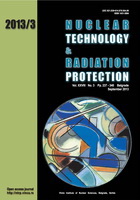
USING AUGMENTED-REALITY AND MOBILE THREE-DIMENSIONAL GRAPHICS TECHNIQUES IN RELIEF WORK ON RADIOLOGICAL DISASTER SITES

Vol.
XXVIII, No. 3, Pp. 237-340
September 2013
UDC 621.039+614.876:504.06
ISSN 1451-3994
Pages: 332-340
Authors: Ming-Kuan Tsai, Nie-Jia Yau
Abstract
Many countries tightly manage and monitor various radiological sources and facilities, yet some serious radiological disasters still occurred in recent decades. In order to reach effective relief work on radiological disaster sites, numerous information techniques have become popular, i. e. global positioning system, geographical information system, computer simulation, and three-dimensional graphics. However, this study recognizes insufficient information service in global positioning system and geographical information system and inconvenient information operation in computer simulation and three-dimensional graphics. Therefore, this study adopts augmented-reality and mobile three-dimensional graphics techniques to construct a mobile relief work system. This system helps relief workers to comprehend the spatial relationship among their localities, the targeted constructions, and the anticipated shelters. Based on the testing results regarding escaping victims, through the mobile relief work system in contrast to a Google maps-based system, relief workers more easily arrive at the targeted constructions, and more rapidly seek the anticipated shelters. In sum, this study is useful for similar applications in disaster management.
Key words: augmented-reality, disaster management, geographical information system, global positioning system, radiological disaster, three-dimensional graphic
FULL PAPER IN PDF FORMAT (1.17 MB)